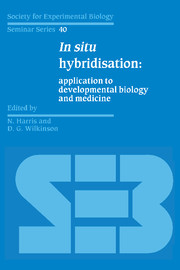Book contents
- Frontmatter
- Contents
- List of contributors
- Preface
- Non-radioisotopic labels for in situ hybridisation histochemistry: a histochemist's view.
- Use of haptenised nucleic acid probes in fluorescent in situ hybridisation
- The use of complementary RNA probes for the identification and localisation of peptide messenger RNA in the diffuse neuroendocrine system
- Contributions of the spatial analysis of gene expression to the study of sea urchin development
- Advantages and limitations of in situ hybridisation as exemplified by the molecular genetic analysis of Drosophila development
- The use of in situ hybridisation to study the localisation of maternal mRNAs during Xenopus oogenesis
- In situ hybridisation in the analysis of genes with potential roles in mouse embryogenesis
- Evolution of algal plastids from eukaryotic endosymbionts
- Localisation of expression of male flower-specific genes from maize by in situ hybridisation
- Tissue preparation techniques for in situ hybridisation studies of storage-protein gene expression during pea seed development
- Investigation of gene expression during plant gametogenesis by in situ hybridisation
- Sexing the human conceptus by in situ hybridisation
- Non-isotopic in situ hybridisation in human pathology
- The demonstration of viral DNA in human tissues by in situ DNA hybridisation
- Index
Evolution of algal plastids from eukaryotic endosymbionts
Published online by Cambridge University Press: 04 August 2010
- Frontmatter
- Contents
- List of contributors
- Preface
- Non-radioisotopic labels for in situ hybridisation histochemistry: a histochemist's view.
- Use of haptenised nucleic acid probes in fluorescent in situ hybridisation
- The use of complementary RNA probes for the identification and localisation of peptide messenger RNA in the diffuse neuroendocrine system
- Contributions of the spatial analysis of gene expression to the study of sea urchin development
- Advantages and limitations of in situ hybridisation as exemplified by the molecular genetic analysis of Drosophila development
- The use of in situ hybridisation to study the localisation of maternal mRNAs during Xenopus oogenesis
- In situ hybridisation in the analysis of genes with potential roles in mouse embryogenesis
- Evolution of algal plastids from eukaryotic endosymbionts
- Localisation of expression of male flower-specific genes from maize by in situ hybridisation
- Tissue preparation techniques for in situ hybridisation studies of storage-protein gene expression during pea seed development
- Investigation of gene expression during plant gametogenesis by in situ hybridisation
- Sexing the human conceptus by in situ hybridisation
- Non-isotopic in situ hybridisation in human pathology
- The demonstration of viral DNA in human tissues by in situ DNA hybridisation
- Index
Summary
Introduction
Endosymbiosis has been a key process in the evolution of eukaryotes. Molecular phylogenetic data prove ‘beyond reasonable doubt’ that mitochondria and green chloroplasts are of eubacterial origin (Pace et al., 1986), probably derived from endosymbionts (Margulis, 1981). Hence, the eukaryotic cell is a polyphyletic chimera of two or more organisms created by cross-bridges between different streams of evolution. Accordingly, the plant cell comprises three subcellular compartments (cytoplasm, chloroplast and mitochondrion) derived from three distantly related organisms now amalgamated into a single cell (Margulis, 1981). However, the morphology of certain algal cells (e.g. the Divisions (or Phyla) Cryptoophyta and Chlorarachniophyta) suggests that they contain four different subcellular compartments; possibly derived from a union of two eukaryotes (Whatley & Whatley, 1981, Cavalier-Smith 1988, Cattolicco, 1986, Cavalier-Smith & Lee, 1985). In order to determine the affinity of the sub-cellular compartments in these algae, high resolution in situ hybridisation using lineage specific probes for rRNA has been employed. This cytochemical approach demonstrates that cryptomonads and Chlorarachnion not only have two prokaryotic subcelluar compartments (plastids and mitochondria) but also contain two eukaryotic subcellular compartments, each with 80S-like eukaryotic ribosomes and a nucleus. These results support the hypothesis that certain algae attained their plastids from eukaryotic endosymbionts, and that vestigial remnants of the endosymbionts nucleus and cytoplasm remain in the algal cells (Whatley & Whatley, 1981; Hibberd & Norris, 1984; Ludwig and Gibbs, 1985, 1987, 1989; Hansmann, 1988).
- Type
- Chapter
- Information
- In Situ HybridisationApplication to Developmental Biology and Medicine, pp. 143 - 156Publisher: Cambridge University PressPrint publication year: 1990
- 3
- Cited by

